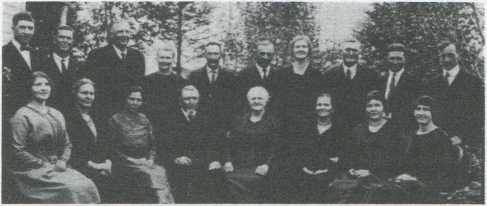Stella (b. 25 Jul 1892) married Zack Kapler; and Albina (b. 1 Apr 1895) married Adolph Kovarik.

(Vaclav) Wenzel Koudelka family picture.
Front row, left to right: Stella Koudelka Kapler, Anna Koudelka Praska, Mary Praska Koudelka, Father Wenzel Koudelka, Mother Mary Voyek Koudelka, Katherine Capouch Koudelka, Emma Koudelka Kobliska and Albina Koudelka Kovarik. Back row, left to right: Zak Kapler, John G. Praska, Frank W. Koudelka, Mary Koudelka Marik, Thomas Marik, William Lukes, Rose Koudelka Lukes, Albert Koudelka, Joseph Kobliska and Adolph Kovarik.
Vaclav and Marie retired to Protivin, lAand resided there until their deaths. Vaclav died 26 Aug 1926 and Marie died 2 Feb 1927. They are buried in the Holy Trinity Church Cemetery at Protivin.
Vaclav was a talented musician and played the Bass Horn with the Protivin Band.
Kovarik, John and Elizabeth (Riha)
(Rebecca Neuzil)
Born in Vsetec, Bohemia, 10 Aug 1850, to John and Mary (Jira) Kovarik, John J. Kovarik, the oldest of 8 children, came to Spillville, IA with his parents in 1868. In 1869 he was employed by Father Francis Mikota as school teacher, organist, and choir master for St. Wenceslaus Parish. Since there was no school building, classes for the children were conducted in the rectory. But the place was small. Because the presence of the children tended to disrupt rectory activities, a place for a class room was found that winter above Thomas Dvorak's saloon. After marriage in Feb 1870 to Elizabeth Riha in Prairie du Chien, Wl, John J. continued to live with his parents until 1871. That year a parochial school was constructed on the 10 acres of land which Roman Expelier and his wife had deeded to the parish in Dec 1859. Only part of the large two-story, stone structure was used for classes. The rest of the building served as living quarters for John J. Kovarik and his family.
Kovarik taught the immigrant children and their own children for almost a quarter of a century. As a teacher, Mr. Kovarik had the distinct advantage over his contemporaries in the township schools of being able to instruct in all three of the languages spoken by his pupils: Czech, German and English. The average number of pupils was 60, though in winter, attendance increased to as many as 110. Obviously, with that many children, Kovarik was forced to restrict the curriculum to basics. Though it might be assumed that with such a large group, his charges would be short-changed, that was not the case. He worked hard to give his charges more than a cursory education, and several of the children, who knew only Czech when they began their formal education, did so well that they went on to become professional educators; Procopius Neuzil became a teacher, then a priest, and at age 26, founded St. Procopius College in Lisle, IL. Later he helped establish and was editor of the Benedictine Abbey Press. In time, he was elected Abbot of the Abbey. Alois Kovarik went on to earn a doctorate at the University of Minnesota and became a Professor of Physics at Yale University. James S. Mikesh became an author and theologian, and taught at Yale and at Harvard.
Mary E. Klimesh, who was one of his pupils, called J.J. Kovarik a “very good teacher." She recalled that he was very strict, yet kind to the children. The blackboard was above a low platform. When the children were inattentive, he had them come to the front of the room and kneel on it. Mary admitted that this misfortune occurred to her several times. On one occasion, Kovarik noticed that she was getting light-headed, and sent her to the kitchen to ask his wife for a sip of wine to refresh her. Another time, a youngster who boarded in town, was caught writing a letter home, a transgression which normally would have resulted in a trip to the platform. Kovarik read the letter, and without comment, handed it back. In it, the boy had written that “uncle isn’t as rough as he used to be.” The boy’s mother was Kovarik's sister.
Kovarik's love was music. The school day started with Holy Mass at which Kovarik played the organ and the children sang. An evening a week, he devoted to choir practice. At other times, he taught music to his children, and to others. Even the family recreation centered on music and periodically, some of the towns-people gathered at Kovarik’s house for a prolonged songfest.
In 1893, after J.J. Kovarik gave up his teaching post to devote more time to his music, he was appointed postmaster and became more active in civic affairs, which included a term as mayor of Spillville. After moving to New Prague, MN in 1899, he continued his musical career as a music teacher, orchestra leader, and choir master.
John J. and Elizabeth Kovarik were the parents of seven children, four of whom adopted music as their life’s work. Joseph, the oldest, attended music school in Milwaukee and graduated from the Conservatory of Prague, Bohemia. While there, he met Czech composer Anton Dvorak, became his friend and companion. During Dvorak’s stay in America, he served as his secretary and was responsible for Dvorak’s visit to Spillville during the summer of 1893. Kovarik was a member of the New York Philharmonic Orchestra for 41 years, was a violin and viola instructor at the National Conservatory of Music and at the New York College of Music.
John, the second oldest son, died at age 21. Cecelia, born about 1875, taught school and music, and was a church organist. Elizabeth, born in 1877, married John Bruzek. Mary, born in 1879, died before attaining her 10th birthday. Frank J. played the viola for the Minneapolis Symphony Orchestra and directed several small college or
K-52
Complete OCR transcription.
See the associated scan to compare with the published information.

